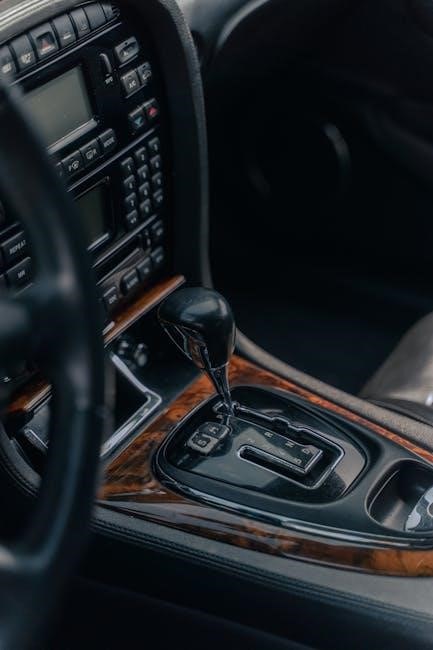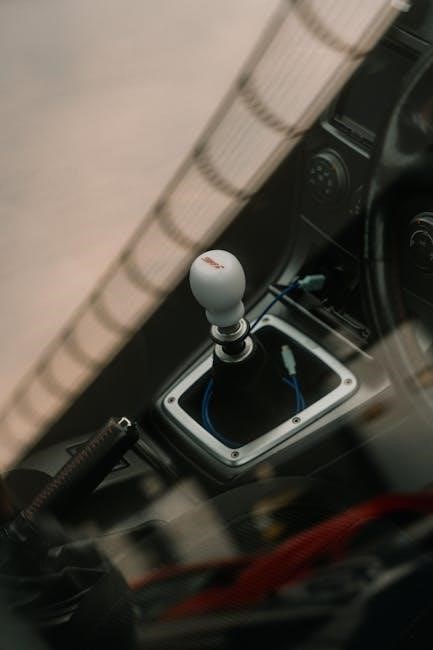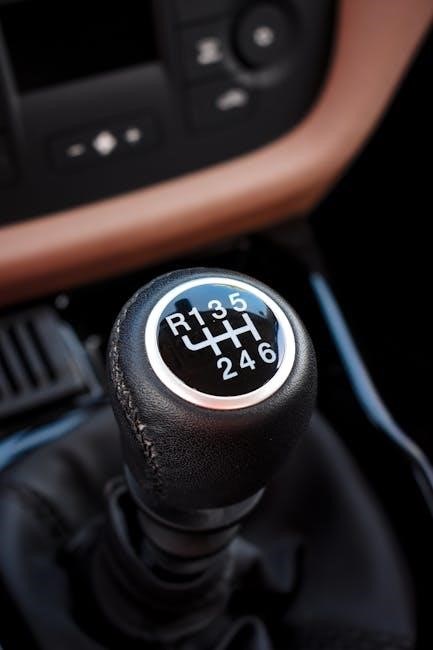The E36 manual gearbox, available in Getrag 250G and ZF 320Z variants, enhances driving dynamics with precise control and durability. Ideal for both daily driving and performance enthusiasts, offering a balance between everyday usability and sporty handling.

Overview of the E36 Model and Its Transmission
The BMW E36, produced from 1991 to 1999, is a compact executive car renowned for its sporty handling and robust engineering. The manual transmission in the E36 plays a pivotal role in its driving experience, offering precise control and responsiveness. Two primary gearbox types are available: the Getrag 250G, found in most models, and the ZF 320Z, reserved for higher-performance variants like the 328i and M3. These transmissions are designed to complement the E36’s rear-wheel-drive layout, providing smooth power delivery and engagement. The Getrag 250G is lightweight and efficient, while the ZF 320Z is built for durability, handling higher torque outputs. Both gearboxes are celebrated for their mechanical simplicity and reliability, making the E36 a favorite among enthusiasts. Regular maintenance, such as fluid changes, is essential to ensure optimal performance and longevity of the transmission.
Importance of Manual Gearboxes in the E36
Manual gearboxes in the E36 are integral to its driving appeal, offering direct driver engagement and precision. They enhance fuel efficiency and cost-effectiveness compared to automatics. The ability to manually shift gears provides better control, especially in spirited driving scenarios. Additionally, manual transmissions are lighter and simpler, contributing to the E36’s balanced weight distribution and agility. This simplicity also reduces maintenance needs compared to complex automatic systems. For enthusiasts, the tactile experience of shifting gears is irreplaceable, making the E36 a timeless choice for purists. The availability of performance-oriented gearboxes, like the ZF 320Z in higher models, underscores their role in delivering power effectively. Overall, the manual gearbox complements the E36’s sporty ethos, making it a preferred option for drivers seeking both performance and connection to the road.

Types of E36 Manual Gearboxes

The E36 features two primary manual gearboxes: the Getrag 250G and the ZF 320Z. The Getrag is common in most models, while the ZF is found in higher-performance variants like the M3 and 328i.

Getrag 250G Gearbox Specifications
The Getrag 250G is a 5-speed manual gearbox widely used in the E36 series, known for its durability and lightweight design. It features a torque capacity of up to 240 Nm, making it suitable for most E36 models. The gearbox is paired with engines producing moderate power, offering smooth shifting and reliable performance. Its compact design and efficient gear ratios make it ideal for both city driving and spirited performance. The Getrag 250G is also compatible with various E36 models, including the 318i, 323i, and 325i, showcasing its versatility. While it is less robust than the ZF 320Z, it remains a popular choice for enthusiasts due to its simplicity and ease of maintenance.
ZF 320Z Gearbox Specifications
The ZF 320Z is a high-performance 5-speed manual gearbox used in the E36 328i and M3 models. Designed for robust performance, it can handle up to 800 Nm of torque, making it suitable for powerful engines. The ZF 320Z features a stronger internal structure and advanced gear ratios. It is known for its smooth shifting and excellent durability. This gearbox is ideal for high-torque applications and is a preferred choice for enthusiasts seeking a more robust transmission. The ZF 320Z is also compatible with various E36 models, including the 328i and M3, showcasing its versatility. While it is more durable than the Getrag 250G, it remains a reliable option for both performance driving and everyday use.
Compatibility Between E36 Models
The E36 manual gearbox models, including the Getrag 250G and ZF 320Z, offer varying levels of compatibility across different E36 variants. The Getrag 250G is commonly used in most E36 models, such as the 318i, 323i, and 325i, while the ZF 320Z is exclusively found in the 328i and M3 due to its higher torque capacity. Both gearboxes share similar mounting points and connections, making them interchangeable with minimal modifications. However, gear ratios differ slightly between the two, which can affect driving dynamics. Additionally, some E46 models, like the 323i and 325i, also use the Getrag 250G, further expanding compatibility. While swapping gearboxes is possible, it’s important to ensure compatibility with the specific E36 model and engine configuration to maintain optimal performance and reliability. This flexibility makes the E36 a popular choice for enthusiasts looking to upgrade or modify their transmissions.

Maintenance and Fluid Requirements
Regular fluid changes with BMW-approved MTL are essential for E36 manual gearboxes. Proper lubrication ensures smooth operation and extends gearbox lifespan, especially under high-stress conditions like spirited driving or increased torque.
Recommended Transmission Fluids for E36 Gearboxes
For E36 manual transmissions, BMW recommends using MTL (Manual Transmission Lubricant), specifically 70W80 GL-4 fluid. This synthetic oil ensures optimal gear lubrication, reduces wear, and maintains smooth shifting. It’s compatible with both Getrag 250G and ZF 320Z gearboxes, providing consistent performance across various driving conditions. Regular fluid changes, typically every 30,000 to 60,000 miles, are crucial for maintaining gearbox health. Using the correct fluid type is essential to prevent damage and ensure longevity. Always refer to the owner’s manual or consult a BMW specialist for confirmation on the appropriate fluid for your specific E36 model.
Fluid Change Intervals and Procedures
Regular fluid changes are essential for maintaining the health and performance of the E36 manual gearbox. BMW recommends changing the transmission fluid every 30,000 to 60,000 miles, depending on driving conditions. The process involves draining the old fluid, inspecting for contamination, and refilling with the specified MTL (Manual Transmission Lubricant). Proper procedure ensures gears remain lubricated, reducing wear and preventing premature failure. Always consult the owner’s manual or a BMW specialist for exact intervals and guidelines tailored to your vehicle’s specific needs and usage patterns. Regular maintenance helps extend the gearbox’s lifespan and maintains smooth, precise shifting.

Upgrading or Swapping the Gearbox
Upgrading or swapping the E36 manual gearbox involves meticulous planning, ensuring compatibility with engine power and drivetrain components. The ZF 320Z is a popular choice for higher torque applications, offering enhanced durability and performance for modified or high-power engines, while the Getrag 250G remains suitable for stock or mildly tuned setups. Proper alignment, mounting, and wiring are critical for a successful swap, and consulting a detailed guide or a professional is highly recommended to avoid costly mistakes and ensure seamless integration with the vehicle’s systems. Always verify compatibility with your specific E36 model to maintain optimal performance and reliability.

Step-by-Step Guide to Manual Transmission Swap
Initiate by gathering all necessary tools and components, including the new manual transmission, clutch kit, and wiring harness. Begin by disconnecting the battery to prevent electrical issues. Remove the driveshaft and secure the vehicle on a lift or jack stands for easy access. Disconnect the shifter and electrical connectors from the automatic transmission. Carefully lower and remove the automatic transmission, taking note of its position and mounting points. Inspect and clean the area before installing the manual transmission, ensuring proper alignment with the engine and chassis. Reconnect the shifter, electrical connectors, and driveshaft, making sure all components are securely fastened. Reconnect the battery and test the transmission by shifting through all gears to ensure proper engagement; Finally, check for any leaks and test drive the vehicle to confirm smooth operation.
Considerations for Upgrading to a More Robust Gearbox
Upgrading to a more robust gearbox, such as the ZF 320Z, is ideal for handling higher torque outputs, making it suitable for powerful engines. Ensure compatibility with your vehicle’s specifications, as the ZF 320Z is typically found in higher-end models like the 328i and M3. Consider the cost and complexity of installation, which may require professional expertise. Gear ratios should align with your driving style, whether prioritizing acceleration or efficiency. Additionally, verify compatibility with your drivetrain to avoid unnecessary modifications. Finally, consider the warranty implications and support availability for the upgraded gearbox, ensuring it meets your performance and reliability needs.

Common Issues and Troubleshooting
Common issues include synchronizer wear, bearing failure, and gear ratio mismatches. Regular fluid changes and inspections are essential for maintaining gearbox health and preventing costly repairs.
Synchronizer Wear and Repair
Synchronizer wear is a common issue in E36 manual gearboxes, particularly in high-mileage vehicles. Symptoms include grinding gears, difficulty shifting into lower gears, and a “banging” sound during downshifts. The synchronizer’s role is to match gear and shaft speeds during shifting, and wear can occur due to high mileage, aggressive driving, or insufficient transmission fluid. Repair typically involves replacing the synchronizer kit, which includes the synchronizer rings, hubs, and springs. The gearbox must be disassembled, requiring mechanical expertise. If ignored, worn synchronizers can lead to further damage, such as gear tooth wear. Regular fluid changes and smooth driving practices can help prevent premature wear. Always use the recommended transmission fluid, like Redline MT-85, to maintain gearbox health. Early detection and repair are crucial to avoid costly overhauls.
Bearing Failure and Replacement
Bearing failure in the E36 manual gearbox can manifest as grinding noises, vibration during gear shifts, or resistance when engaging gears. It often results from high mileage, aggressive driving, or inadequate lubrication. The input and output shaft bearings are particularly prone to wear. Replacement requires disassembling the gearbox, which is a complex process demanding specialized tools and mechanical expertise. DIY repairs are challenging for inexperienced owners, so professional assistance is recommended. Regular transmission fluid changes with high-quality lubricants, such as Redline MT-85, can help extend bearing life. Early detection of symptoms is crucial to prevent further damage to gears and other components. Proper driving habits, like smooth shifting, also contribute to bearing longevity. Addressing bearing issues promptly ensures reliable performance and avoids costly repairs down the line.